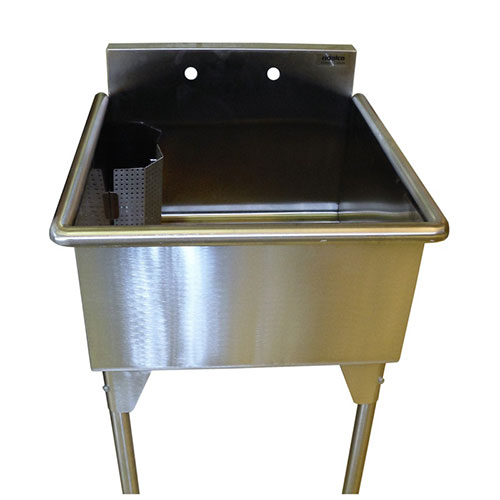Tips for Specifying a Sink
Having to contour your body to ensure the water stays within the sink while washing your hands is unpleasant. Having to slouch your body to scrub dishes within the sink is unbearable. Despite us interacting with a sink numerous times a day, we often forget about the way they can interrupt our lives on a daily basis. In this guide, we'll give you the necessary tools to specify a sink that will fit your needs.
Ergonomic Comfort
When specifying a sink, the top priority on everyone's list should be ergonomic comfort. This means selecting a sink that meets where the user's body naturally rests. While this sounds like an obvious specification, it is perhaps the most difficult task. This is because there are two choices that impact ergonomic comfort: the basin depth and drain location.
Below is a chart which indicates the ideal bowl depth based on the height of the user and an undermounted sink:
While choosing an ergonomic sink is not enforced, having one means less muscle fatigue, increased productivity, and alleviation of stressors on the body.
Sink Installation Types
When considering the type of sink to install, the first aspect you need to consider is how compatible the sink style will be with your countertop. If you are electing to purchase a new countertop, your options will be grander than if you are working with a preexisting counter. Below we take a look at the different sink styles and their installation requirements.
Drop-In/Self-Rimming
As the name 'drop-in' implies, the sink is lowered inside the counter top. The counter top has a hole that is large enough to fit the bowl of the sink, however, small sized so that the rim of the sink remains on top. So the sink is held into place by the rim of the sink that rests on top of the counter. These sinks are commonly used and are known for being the easiest to install.
Undermount
For those looking to have a seamless counter top, then choosing an undermount sink is ideal. With an undermount, the sink is installed below the counter top and held into place by metal anchors and silicone caulk or high-strength epoxy.
Semi-Recessed: Installed similarly to the drop-in sink, a semi-recessed sink sits partially above the counter top and partially below it. This allows for a depth to be added to the sink.
Wall-Mount: A wall-mount sink is installed directly on to the wall and is another ideal choice for a bathroom with minimal space available.
Farmhouse/Apron
One of the least common styles of today, the farmhouse/apron sink is installed below the counter top. Unlike an undermount sink that is hidden, the farmhouse/apron sink features an exposed front.
Above Counter/Vessel
As the name implies, the sink sits above the counter and requires a pop-up drain to function. If you are looking to keep the same countertop and are wanting to cover your existing sink hole, you can do so by selecting a rectangular vessel sink.
image © Wiki Commons
Integrated: An integrated sink is one that is constructed within the countertop piece. While this style allows for quick cleaning, it means that if the sink needs to be replaced, the entire counter will have to be replaced with it.
Pedestal: In bathrooms with limited space, a pedestal sink could be an ideal choice since it takes up minimal floor space as it stands within a slim support column.
Materials
When it comes to choosing a material for your sink, there are a plethora of options available. To narrow them down, you want to ensure that you pick a material that will compliment your other bathroom or kitchen finishes. For example, you wouldn't want to have a copper sink if the rest of your accessories such as towel bars, dispensers, and faucets are stainless steel.
This is a list of the most common materials used for sinks:
Stainless Steel: Commercial and residential residences prefer stainless steel sinks since they are durable, relatively inexpensive, and resistant to heat, ultraviolet rays, and limescale.
Porcelain: A common choice for washrooms, Porcelain is easy to clean, durable, and resistant to discoloration and corrosion. While it is durable, if it's hit with a heavy object, it can chip.
Stone: A stone sink is traditionally sculpted out of soapstone, marble, limestone, or granite. The expense of the sink is heavily dependent on the stone chosen, however, in general a stone sink is typically more expensive than others. A stone sink is difficult to break or chip, however, it is prone to staining. It's important to ensure it is properly sealed and regular maintenance of staining may be required to keep the stone pristine.
Solid-Surface: If you desire the look of stone, but don't want to be committed to the maintenance, then a solid-surface composite material will be your best bet. You'll have the look of stone with easier maintenance.
Enamel-Coated Cast Iron: Featuring smooth surfaces and edges, an enamel-coated cast iron sink is easy to clean and is available in a variety of colours. When cleaning, it's imperative to check for chips in the enamelling as the bare iron will rust. You also must be cautious of abrasive cleaners as they will destroy the shine of your sink.
Fireclay: A Fireclay sink is generally more expensive than others. This is because it's handmade from a special white clay that is only found in certain regions of the world. The clay goes through a process of being mixed with water, then poured into molds, and eventually dried in humidity-controlled rooms. Once the clay is set, it gets hand-glazed and then fired at over 2100° Fahrenheit. This process produces a new material that is highly durable and incredibly damage resistant compared to other sink materials.
Copper: If you're looking for minimal maintenance, than a copper sink is desirable. Copper has strong antimicrobial properties, does not tarnish or rust, and can be selected in a variety of shades. While it can corrode over time, properly sealing the sink will prevent corrosion.
Glass: While you may immediately assume it is delicate, the common types of glass chosen are tempered or safety glass which are strong materials. It is easy to clean, however, can get water and/or soap spots.
Fiberglass: While fiberglass is inexpensive and can be moulded into a variety of shapes and sizes, it's perhaps one of the least common choices. This is because despite its strength and lightweight nature, it is not durable or long lasting.
Ultimately, when it comes to specifying a sink, you need to consider the ergonomic comfort, the strength, maintenance required, and their integration with not only countertops but also faucets. To further help you with your selection process, check out our guide on selecting faucets found here.
If you are ready to specify a sink, browse through the selection of sinks found on CADdetails here.
cover photo © unsplash











